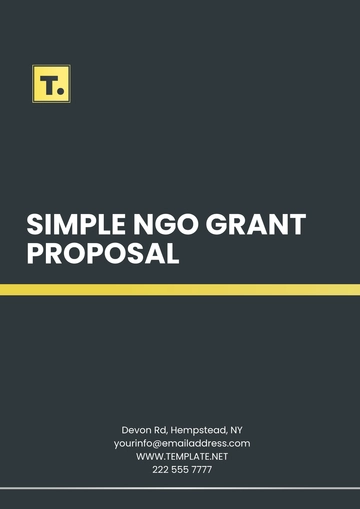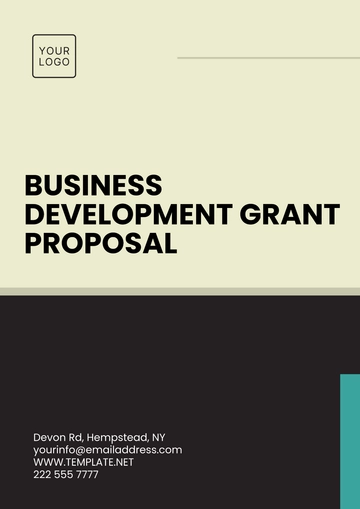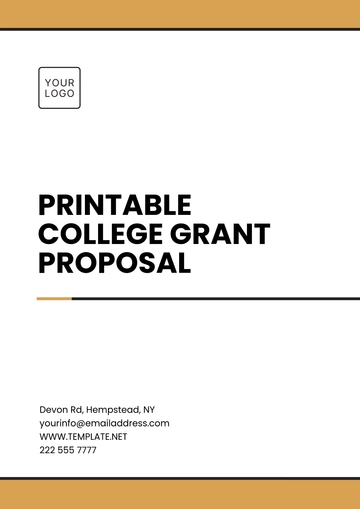Free Agriculture Grant Proposal

I. Introduction
A. Background and Context
The agricultural sector in [Country] faces significant challenges exacerbated by climate change and resource constraints. With a predominant reliance on traditional irrigation methods, farmers often struggle to maintain crop yields amidst fluctuating water availability and escalating production costs. This proposal seeks to introduce sustainable practices that enhance agricultural resilience and productivity while mitigating environmental impacts.
B. Statement of the Problem or Opportunity
Recent periods of drought combined with unpredictable and irregular rainfall patterns have highlighted in stark terms the critical need for the adoption of sophisticated irrigation technologies as well as the implementation of comprehensive integrated pest management strategies in [Region]. By proactively addressing and overcoming these significant agricultural and environmental challenges, our goal is to strengthen food security, enhance the quality of life and economic conditions for local communities, and safeguard natural resources in a sustainable manner for the benefit of both present and future generations.
C. Objectives of the Proposal
[Your Company Name]'s proposal aims to:
Design and deploy precision irrigation systems that are specifically tailored to the unique soil conditions of the local area, thereby ensuring that water use is optimized to its highest potential efficiency.
Provide comprehensive training to farmers on integrated pest management techniques, with the goal of reducing their dependency on chemical pesticides and enhancing the overall health and resilience of their crops.
Encourage and support initiatives that are led by community members and focus on the implementation of agriculture practices that are sustainable. These initiatives should aim to enhance the community's ability to withstand fluctuations in climate patterns as well as navigate and adapt to uncertainties within the economy. By fostering such community-driven projects, we can build a more resilient and stable agricultural foundation.
II. Literature Review
A. Review of Relevant Literature and Research
Studies by [Researcher's Name] (Year) have demonstrated that precision irrigation systems significantly enhance crop yields while minimizing water consumption in similar semi-arid regions. Furthermore, research on integrated pest management strategies has shown promising results in reducing chemical inputs and improving natural pest control mechanisms among diverse crop varieties ([Researcher's Name] et al., [Year]).
B. Gap Analysis: Identification of Knowledge Gaps or Challenges
Although the numerous advantages of these technologies have been clearly demonstrated, their adoption by smallholder farmers in [Region] has been surprisingly minimal. Several factors contribute to this slow uptake, including the high initial investment costs required to implement such technologies, a general lack of technical expertise among the farmers, and insufficient access to financing options specifically geared toward sustainable agricultural practices. Addressing and overcoming these obstacles is essential for harnessing the complete potential of agricultural productivity and sustainability within the region.
III. Project Objectives and Goals
A. Specific Objectives of the Project
During the initial year, the objective is to set up and exhibit the effectiveness of precision drip irrigation systems across 100 hectares of farms dedicated to the cultivation of [Crop] in the specified [Target Area].
The primary objective of this initiative is to provide comprehensive education and training to a group of 200 local farmers, equipping them with the knowledge and skills necessary to implement integrated pest management techniques. The project aims for a 30% reduction in chemical pesticide use by training farmers in eco-friendly pest control, fostering a healthier ecosystem and sustainable agriculture by its second year.
The objective is to establish a Farmer Field School program with the purpose of creating a platform where knowledge exchange can continuously occur, promoting the adoption of sustainable agricultural practices. This program aims to support around 500 farming households with training and resources to foster environmentally responsible farming, enhancing both economic and environmental sustainability.
B. Alignment with Agricultural Priorities or Sustainable Development Goals
This project aligns with [Region]'s agricultural priorities outlined in the [Relevant Policy], emphasizing sustainable water management, climate resilience, and improved food security. By promoting resource-efficient practices, the project supports the achievement of Sustainable Development Goals (SDGs) related to zero hunger, clean water and sanitation, and climate action.
IV. Methodology
A. Research Design or Project Plan
The project will be implemented over a three-year period, divided into three phases: preparation, implementation, and evaluation. During the preparation phase, stakeholders will be engaged through consultations and baseline assessments to tailor interventions to local needs. Implementation will focus on the installation of irrigation systems, delivery of training workshops, and establishment of demonstration plots. The evaluation phase will include regular monitoring of project activities, impact assessments, and dissemination of findings to stakeholders.
B. Description of Methods and Approaches
Precision Irrigation Systems
The process involves the installation of drip irrigation systems that are specifically tailored to match the distinct soil types and water requirements of [Crop]. This task will be executed through close collaboration and consultation with local irrigation experts to ensure that all factors contributing to the efficient and effective distribution of water to the crops are considered and optimized.
Integrated Pest Management (IPM)
Training sessions and on-farm demonstrations are being organized to introduce farmers to various agricultural techniques, including biocontrol methods, crop rotation strategies, and the use of pest-resistant crop varieties that are specifically adapted to local environmental conditions.
Community Engagement
The implementation of participatory approaches, which include methods such as Farmer Field Schools and farmer-to-farmer learning networks, is essential in ensuring both broad adoption and the long-term sustainability of the various interventions introduced by the project.
C. Justification of Methodological Choices
The chosen methods are based on evidence from successful case studies and consultations with local agricultural stakeholders. By integrating participatory approaches and focusing on capacity building, the project aims to empower farmers to become agents of change in adopting and scaling up sustainable agricultural practices across [Region].
V. Expected Outcomes and Deliverables
A. Anticipated Results and Impacts
The project anticipates significant improvements in crop yields, with an estimated increase of 20% due to enhanced water management practices facilitated by precision irrigation systems. Reductions in pesticide use by 30% through the adoption of integrated pest management strategies are expected to contribute to improved environmental health and farmer livelihoods. Additionally, the project aims to foster community resilience to climate change by promoting sustainable agricultural practices that mitigate risks associated with extreme weather events.
B. Potential Benefits to Agriculture and Stakeholders
Stakeholders, including farmers, local communities, and agricultural extension services, will benefit from enhanced knowledge and skills in sustainable agriculture. Improved water use efficiency and reduced reliance on chemical inputs will lead to cost savings and increased profitability for participating farmers. By promoting resource-efficient practices, the project aims to contribute to long-term agricultural sustainability and food security in [Region].
VI. Project Implementation Timeline
A. Phases of the Project
Preparation Phase (Month 1-6)
Engage in comprehensive consultations with all relevant stakeholders, complete the process of finalizing the locations for site selections, and carry out the procurement of the necessary equipment and materials required for the installation process.
Implementation Phase (Month 7-24)
Begin the process by installing drip irrigation systems on the farms that have been identified for this purpose. After installation, hold workshops on integrated pest management for farmers and establish Farmer Field Schools for ongoing education and support.
Evaluation Phase (Month 25-36)
Conduct a thorough and continuous monitoring of the project outcomes to evaluate their effectiveness. Investigate and assess the impact that the project has on crop yields, determining any changes or improvements as a result of the interventions. Evaluate the reduction in pesticide use, analyze the data, and compile detailed reports of the findings for stakeholders.
B. Milestones and Timelines for Completion
The significant milestones that we aim to achieve during this project are as follows: Firstly, within the initial year, we plan to complete the installation of the entire irrigation system. Secondly, by the conclusion of the second year, we aim to conduct training sessions that will educate and benefit a total of 200 farmers. Lastly, we will maintain a continuous process of evaluation and adjustment throughout the duration of the project, which will be informed by feedback received from both stakeholders and the beneficiaries of the project.
VII. Budget and Justification
A. Budget Categories
Personnel Costs
The salaries allocated for individuals specializing in project management, experts in agronomy, and field assistants who are engaged in various activities including the implementation, monitoring, and evaluation of the project.
Equipment and Supplies
The process of acquiring various items needed for a specific project, including but not limited to, drip irrigation kits, integrated pest management (IPM) tools, educational materials, and the necessary infrastructure for setting up demonstration plots.
Travel and Fieldwork Expenses
The expenditures incurred in connection with field visits, training workshops, and stakeholder engagement activities throughout the entire region of [Region].
Other Direct Costs
The printing and distribution of educational materials, the rental of venues for the purpose of conducting workshops, and the allocation of contingency funds to address any unforeseen expenses that may arise during the course of the project.
B. Budget Justification: Explanation of Costs
The budget is structured to ensure efficient use of resources while maximizing project impact. Detailed cost estimates are based on market rates, quotations from suppliers, and anticipated needs for effective implementation and monitoring of project activities over the three-year period.
VIII. Evaluation Plan
A. Methods for Monitoring and Evaluation
Quantitative methods will include regular surveys and data collection on crop yields, water use efficiency, and pesticide application rates. Qualitative assessments through focus group discussions and participatory evaluations will gather feedback on the adoption of new technologies and practices. Monitoring and evaluation will be ongoing throughout the project to track progress against predefined targets and ensure accountability in achieving desired outcomes.
B. Criteria for Success and Key Performance Indicators
Success will be measured by the achievement of specific targets, including percentage increases in crop yields and reductions in pesticide use as outlined in project objectives. Key performance indicators will focus on the adoption rates of precision irrigation systems and IPM practices among participating farmers, as well as improvements in income and resilience indicators within targeted communities.
This continued content provides further detail on the expected outcomes, project implementation timeline, budget considerations, and evaluation methods for the Agriculture Grant Proposal. These sections are structured to align with the proposal's overall objectives and ensure clarity in communicating the project's potential impact and feasibility to potential funders or stakeholders. Adjustments can be made based on specific guidelines and requirements provided by the funding agency or institution.
IX. Sustainability and Future Plans
A. Sustainability of Project Outcomes
To ensure long-term sustainability, the project will focus on capacity building through farmer training and establishment of local support networks. Farmer Field Schools will serve as hubs for ongoing education and knowledge exchange, empowering farmers to continue practicing sustainable agriculture beyond the project's duration. Integration of project outcomes into existing agricultural extension services will further institutionalize sustainable practices and facilitate broader adoption across [Region].
B. Long-term Impact and Scalability
The project's scalable model and documented successes will enable replication in other regions facing similar agricultural challenges. Lessons learned and best practices will be shared with policymakers, researchers, and development agencies to inform future interventions and policy decisions. By demonstrating the economic and environmental benefits of sustainable agriculture, the project aims to catalyze broader transformations in agricultural practices and contribute to national goals for food security and environmental stewardship.
X. Partnerships and Collaboration
A. Collaborating Institutions or Organizations
The success of the project hinges on strong partnerships with key stakeholders, including [Name of Local Agricultural Extension Agency], [Name of Research Institute], and [Name of NGO or Community Organization]. Each partner brings unique expertise and resources to support project implementation, knowledge dissemination, and capacity building efforts among local farming communities.
B. Roles and Responsibilities of Project Partners
Collaborating institutions will play integral roles in technical support, training delivery, and monitoring and evaluation activities throughout the project lifecycle. Their collective efforts will ensure comprehensive coverage of project objectives and maximize impact through coordinated outreach and engagement strategies. Regular communication and collaborative decision-making will be prioritized to address challenges and capitalize on opportunities for enhancing project outcomes.
XI. Dissemination and Knowledge Sharing
A. Plans for Dissemination of Results
Project findings will be disseminated through various channels, including peer-reviewed publications, presentations at national and international conferences, and interactive workshops with stakeholders. Additionally, results will be shared through digital platforms and traditional media to reach a diverse audience and facilitate knowledge exchange on sustainable agricultural practices.
B. Outreach and Engagement Strategies
Engagement strategies will focus on fostering dialogue and collaboration with local communities, farmer cooperatives, and government agencies. Interactive platforms such as field demonstrations and knowledge-sharing events will showcase project achievements and encourage adoption of innovative agricultural technologies and practices. By promoting transparency and inclusivity, the project aims to build trust and support for sustainable agriculture initiatives among stakeholders.
- 100% Customizable, free editor
- Access 1 Million+ Templates, photo’s & graphics
- Download or share as a template
- Click and replace photos, graphics, text, backgrounds
- Resize, crop, AI write & more
- Access advanced editor
Introducing the Agriculture Grant Proposal Template from Template.net, an indispensable resource for agricultural innovators. This editable and customizable template features a user-friendly AI Editor Tool, simplifying the creation of comprehensive grant proposals. Tailored for efficiency and precision, it empowers users to outline sustainable farming projects with ease, ensuring clarity and professionalism in every submission.
You may also like
- Business Proposal
- Research Proposal
- Proposal Request
- Project Proposal
- Grant Proposal
- Photography Proposal
- Job Proposal
- Budget Proposal
- Marketing Proposal
- Branding Proposal
- Advertising Proposal
- Sales Proposal
- Startup Proposal
- Event Proposal
- Creative Proposal
- Restaurant Proposal
- Blank Proposal
- One Page Proposal
- Proposal Report
- IT Proposal
- Non Profit Proposal
- Training Proposal
- Construction Proposal
- School Proposal
- Cleaning Proposal
- Contract Proposal
- HR Proposal
- Travel Agency Proposal
- Small Business Proposal
- Investment Proposal
- Bid Proposal
- Retail Business Proposal
- Sponsorship Proposal
- Academic Proposal
- Partnership Proposal
- Work Proposal
- Agency Proposal
- University Proposal
- Accounting Proposal
- Real Estate Proposal
- Hotel Proposal
- Product Proposal
- Advertising Agency Proposal
- Development Proposal
- Loan Proposal
- Website Proposal
- Nursing Home Proposal
- Financial Proposal
- Salon Proposal
- Freelancer Proposal
- Funding Proposal
- Work from Home Proposal
- Company Proposal
- Consulting Proposal
- Educational Proposal
- Construction Bid Proposal
- Interior Design Proposal
- New Product Proposal
- Sports Proposal
- Corporate Proposal
- Food Proposal
- Property Proposal
- Maintenance Proposal
- Purchase Proposal
- Rental Proposal
- Recruitment Proposal
- Social Media Proposal
- Travel Proposal
- Trip Proposal
- Software Proposal
- Conference Proposal
- Graphic Design Proposal
- Law Firm Proposal
- Medical Proposal
- Music Proposal
- Pricing Proposal
- SEO Proposal
- Strategy Proposal
- Technical Proposal
- Coaching Proposal
- Ecommerce Proposal
- Fundraising Proposal
- Landscaping Proposal
- Charity Proposal
- Contractor Proposal
- Exhibition Proposal
- Art Proposal
- Mobile Proposal
- Equipment Proposal
- Student Proposal
- Engineering Proposal
- Business Proposal





























